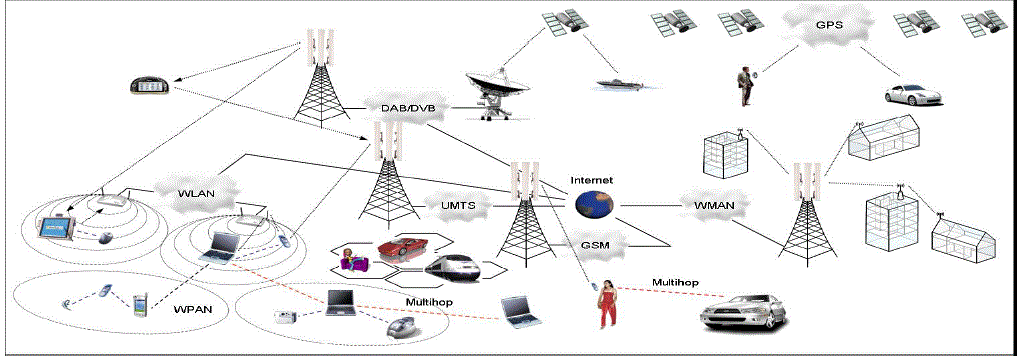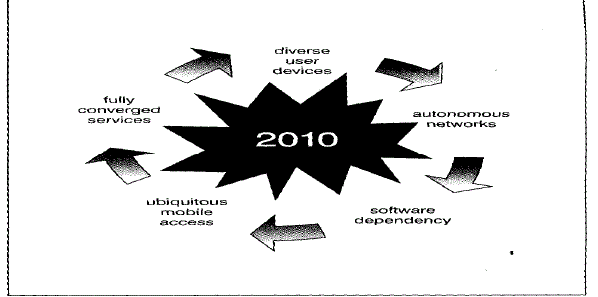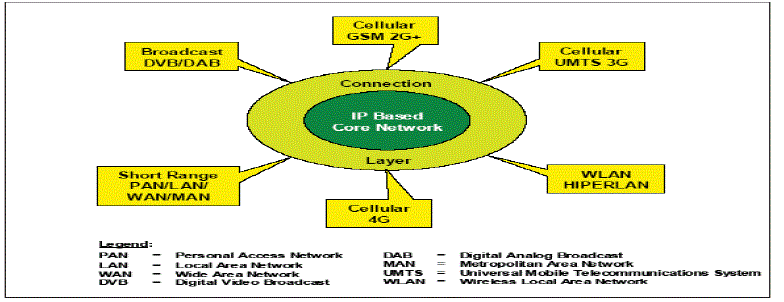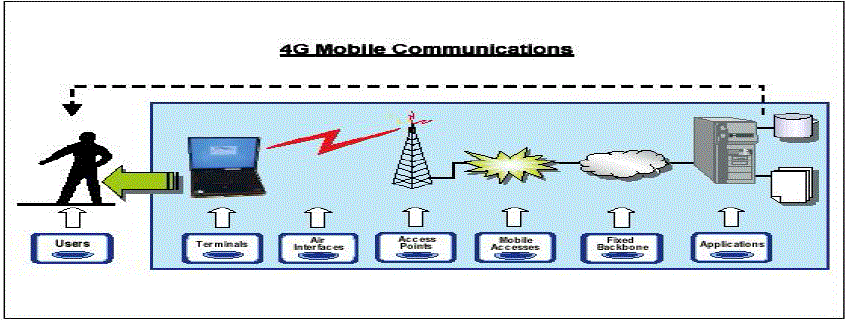INTRODUCTION
|
| In mobile communication systems, after 2G and 3G, the Fourth Generation (4G) was originally expected as ultrahigh speed broadband wireless system. Further, it was assumed that the network will have a cellular structure which implies that it will be built on existing architecture of the preceding generations. A final agreement on what features characterize 4G mobile system, is yet to be reached. Sharing the 4G objectives within research community is still open and lot of features and applications have been suggested by the researchers. Delivery of services to users in different location, under different conditions with quality of service (QoS) available in fixed environment, were some of the major issues. |
| The Wireless World Research Forum (WWRF), aiming at defining features of “beyond 3G” wireless communications, the Japanese MIRAI project, the MobileVCE (Mobile Virtual Centre of Excellence in personal and mobile communications), and several European IST projects (such as Daidalos, Magnet, Simplicity, Ambient Networks, etc.) are only a few examples of international groups devoted to 4G deployment. The European Commission (EC) foresees that from the service point of view, 4G will be mainly a personalized services network. As any service/application/system is to be used by the end user, the system has to be designed taking into account the needs of the user. |
| A first attempt was done in and where user centric approach was introduced, leading to a vision of 4G and its key features and technological development. In addition, 4G will be a convergence platform providing clear advantages in terms of bandwidth, coverage, power consumption and spectrum usage. Further, it will be worth mentioning that the 4G systems are expected to co-exist and inter-work with existing 2G and 3G mobile communication systems as well as satellite, wireless LAN (WLAN), and IEEE 802.16e (also known as Wireless MAN (WMAN) or WiMAX ) networks, all interconnected through the service provider’s IP backbone networks and the Internet as shown in Figure 1. This interconnected network has lead to the evolution of a new paradigm for future communications, namely “Always Best Connected” (ABC), in comparison to typical 2G and 3G concept of “Always Connected”. In new paradigm shift from “Always Connected” to “ABC”, the user will always be connected through the best network, getting the benefit of the best service and access technology. |
| However, to realize the above benefits, each terminal device, used in 4G networks, need to support multi-mode, multi-access and reconfiguration capabilities. That is, each terminal can access more than one type of network and possibly access multiple networks simultaneously for different applications (e.g., one for voice and another for receiving streaming media). In such an environment, a terminal must be able to discover all networks that are available for use. A more challenging issue is to discover and select the best network whenever a handoff is necessary. In a user-centric environment, flexibility and ease-of-access at the user level are essential requirements for the people to adopt the new technology. 4G has been proposed to have both these features for network selection. |
LIMITATIONS OF 3G AND DRIVERS FOR 4G
|
| In the 1G to 2G transition, as well as a transition from analogue to digital we saw a mono-service to multi-service transition. From 2G to 3G, as well as a mono-media to multimedia transition we are also seeing a transition from person-toperson to person-to-machine interactions, with users accessing video, Internet/intranet and database feeds. The 3G to 4G transition, supported by such technologies, will see a transition towards a pre-dominance of automated and autonomously initiated machine-to-machine interactions. Such developments will of course be accompanied by ongoing evolution of already anticipated 3G services, such as send/receive e-mail ,Internet browsing (information),on-line transactions (ebusiness), location-dependent information, company database access, large-file transfer. |
| These services in themselves represent an increase in requirements for accessing information, for business and commercial transactions, as well as for a raft of new location-dependent information services, all including significantly higher bit-rate requirements. There is a requirement for a mixture of unicast, multicast and broadcast service delivery with dynamic variation between application services both spatially and temporally. Above all, there is a demand for ease of user access and manipulation, with minimal user involvement—complexity hidden from the user—and intelligence to learn and adapt with use. From the above it will be seen that 4G will need to be highly dynamic in terms of support for: the users’ traffic, air interfaces and terminal types, radio environments, quality-of-service types, mobility patterns. 4G, then, must itself be dynamic and adaptable in all aspects, with built-in intelligence. Thus a ‘software system’ rather than a hard-and-fixed physical system is indicated. Integration, needed to reflect the convergence issues already mentioned, is also a key to 4G, in particular integration of the radio access and the core network elements, which must be designed as a whole rather than segmented as in the past. Key drivers to 4G will be: |
| 4G FEATURES: a multitude of diverse devices (distributed, embedded, wearable, pervasive),predominance of machine-tomachine communications, location-dependent and e-business applications, the extension of IF protocols to mobility and range of QoS,privacy and security, dynamic networking and air-interfaces, improved coverage mechanisms, improved and dynamic spectrum usage. |
CUSTOMIZING PARAMETERS
|
| Fully converged services: Personal communications, information systems, broadcast and entertainment will have merged into a seamless pool of content available according to the user’s requirement. The user will have access to a wider range of services and applications, available conveniently, securely and in a manner reflecting the user’s personal preferences. |
| Ubiquitous mobile access: The dominant mode of access to this pool of content will be mobile, accounting for all voice communications, the majority of high-speed information services, and a significant proportion of broadcast and entertainment services. Mobile access to commercial and retail services will be the norm, replacing current practices in most cases. |
| Diverse user devices: The user will be served by a wide variety of low-cost mobile devices to access content conveniently and seamlessly. These devices will commonly be wearable—in some cases disposable— and will normally be powered independently of the mains. Devices will interact with users in a multi sensory manner, encompassing not only speech, hearing and sight but also the other human senses, and biological and environmental data pertinent to the application. Special devices tailored for people with disabilities will be common place. |
| Autonomous networks: Underlying these systems will be highly autonomous adaptive networks capable of selfmanagement of their structure to meet the changing and evolving demands of users for both services and capacity. Efficient and cost-effective use of the radio spectrum will be an essential element of their operation, and here, too, autonomy and self management will be the norm. Software dependency: Intelligent mobile agents will exist throughout the networks and in user devices, and will act continually to simplify tasks and ensure transparency to the user. These mobile agents will act at all levels, from managing an individual user’s content preferences to organizing and reconfiguring major elements of networks |
NETWORK SELECTION
|
| In the current cellular systems, which are based on a star-topology, if the base stations are also considered to be mobile nodes the result becomes a ‘network of mobile nodes’ in which a base station acts as a gateway providing a bridge between two remote ad hoc networks or as a gateway to the fixed network. This architecture of hybrid star and ad hoc networks has many benefits; for example it allows self-reconfiguration and adaptability to highly variable mobile characteristics (e.g. channel conditions, traffic distribution variations, load-balancing) and it helps to minimize inaccuracies in estimating the location of mobiles. Together with the benefits there are also some new challenges, which mainly reside in the unpredictability of the network topology due to mobility of the nodes; this unpredictability, coupled with the localbroadcast capability, provides new challenges in designing a communication system on top of an ad hoc wireless network. The following will be required: distributed MAC (medium access control) and dynamic routing support, wireless service location protocols, wireless dynamic host configuration protocols, distributed LAC and QoS-based routing schemes. |
| In mobile IP networks we cannot provide absolute quality-of-service guarantees, but various levels of quality can be ‘guaranteed’ at a cost to other resources. As the complexity of the networks and the range of the services increase there is a trade-off between resource management costs and quality of service that needs to be optimized. The whole issue of resource management in a mobile IP network is a complex trade-off of signaling, scalability, delay and offered QoS.As already mentioned, in 4G we will encounter a whole range of new multirate services, whose traffic models in isolation and in mixed mode need to be further examined. It is likely that aggregate models will not be sufficient for the design and dynamic control of such networks. The effects of traffic scheduling, MAC and CAC (connection admission control) and mobility will be required to devise the dimensioning tools needed to design 4G networks. |
4G TECHNICAL PERSPECTIVE:
|
| It is obvious that 4G, just like all the previous generations, is driven not only by technology, but also by market requirements. This section mainly discusses, from a more technical perspective, possible topics for research and promising techniques of 4G, and focuses mainly on those techniques that give support to the main feature of adaptability by internal diversity of targets in the 4G domain. |
| A. TERMINALS In order to adapt to the diverse applications and networks, together with the various requirements of users, the terminal domain must possess both internal and external diversity. Support techniques of the field may include the following: |
| 1) User interfaces of terminals vary from traditional keyboard, display, and tablet, to new interfaces based on speech, touch, vision, soft buttons, etc. This will be common at a time when one terminal has multiple user interfaces. |
| 2) Adaptive techniques such as smart antennas, software radio, and smart transceivers, enhance interoperability through simultaneous support of several radio interfaces in a single terminal. This makes a terminal roamable across any air interface standard and connectable to any wireless access point by exchanging configuration software. |
| 3) An intelligent terminal is able to dynamically improve its processing capability in order to contain various services. |
| More advances in networks are needed to keep pace with the rapidly changing terminals and applications, as follows: |
| 1) Smart antenna, software radio, together with advanced base station are the key techniques to achieve adaptability of wireless access points to diverse terminals, i.e. to make radio systems and air networks re-configurable. |
| 2) Network layer hierarchical mobility management based on Mobile IPv6 and Cellular IP brings quick and seamless handoff to terminals. The Mobile IPv6 also presents a great contribution to the adaptability of heterogeneous networks. |
| 3) Applications that transmits data while the user os moving -using Hotspots area also being developed. Hotspots are certain areas in which data is received at a higher rate. So when the user passes through this hotspot, the data packets on tended to him are transmitted at a very fast rate. this can also be considered on a system of HSDPA designed on H2. |
APPLICATIONS
|
| Adaptability will be one of the basic requirements to the development and delivery of new mobile services. Promising techniques and possible topics may include: |
| 1) Mobile application should refer to a user’s profile so that it can be delivered in a way most preferred by the subscriber, such as context-based personalized services. This also brings the applications with adaptability to terminals that are moving in varying locations and speeds. Micro-sensors and GPS receivers are the main driven techniques. |
| 2) Techniques such as adaptive multimedia and unified messaging take the terminal characteristics into account and ensure that the service can be received and run on a terminal with the most suitable form to the host type. |
| 3) Intelligent mobile software agent is a common technique to all of the three targets, which act as a platform for service development, delivery, and auto-configuration. |
CONCLUSION
|
| In this project we used a novel algorithm for optimal network selection based on multiple user preferences under heterogeneous network. As 4G system supports multi-mode and reconfigurable devices to support inter-working of heterogeneous networks. The algorithm selects appropriate network during handoff based on user preferences and interests. The user can opt for multiple QoS parameters like bandwidth, cost of service, security level, call drop probability etc.,to select appropriate networks. |
| The proposed algorithm uses a distance function to generate an ordered list of various available access networks in aparticular region according to the multiple user preferences and level of interest The results clearly show that the proposed algorithm always best connect the user, as per his preferences of QoS parameters in a 4G System. |
Figures at a glance
|
 |
 |
 |
 |
| Figure 1 |
Figure 2 |
Figure 3 |
Figure 4 |
|
References
|
- E. Bohlin, S. Lindmark, J. Bjrkdahl, A. Weber, B. Wingert, P. Ballon, ”The Future of Mobile Communications in the EU: Assessing the Potential of 4G”, ESTO Publications, February, 2004.
- S. Frattasi, F. Fitzek,”Preliminary Recommendation for Overall Scenarios and Requirements”, JADE Deliverable 1.1.1, June, 2004.
- WWRF, http:// wireless-world-research.org/, Book of vision 2001www
- M. Inoue, K. Mahmud, M. Hasegawa, H. Muratami, G. Wu, MIRAI: A Solution to Seamless Integration of Heterogeneous Wireless Networks, CT +2002
- J. M. Pereira, ”Fourth Generation: Now, it is Personal”, Proceedings of the 11th IEEE International Symposium on Personal, Indoor and Mobile Radio Communications (PIMRC), London, UK, September 2000.
- S. Frattasi, H. Fathi, F. Fitzek, K. Chung, R. Prasad,”4G: The User- Centric System”, Mobile e-Conference (Me), Electronic Conference, August, 2004.
- S. Frattasi, H. Fathi, F. Fitzek, M. Katz, R. Prasad,”A Pragmatic Methodology to Design 4G: From the User to the Techn01ology”, in roceedings of the 5th International Conference on Networking (ICN), IEEE, Reunion Island, France, April 17-21, 2005.
- IEEE 802 standards, http:// www.ieee802.org
- WiMAX, http://www.wimaxforum.org.
- V. Gazis, N. Alonistioti, L. Merakos, Toward a Generic “Always Best Connected” Capability in Integrated WLAN/UMTS Cellular Mobile Networks (and Beyond), IEEE Wireless Communications, June 2005
- E. Gustafsson, A. Jonsson, Always Best Connected, IEEE Wireless Communications, February 2003.
-
|